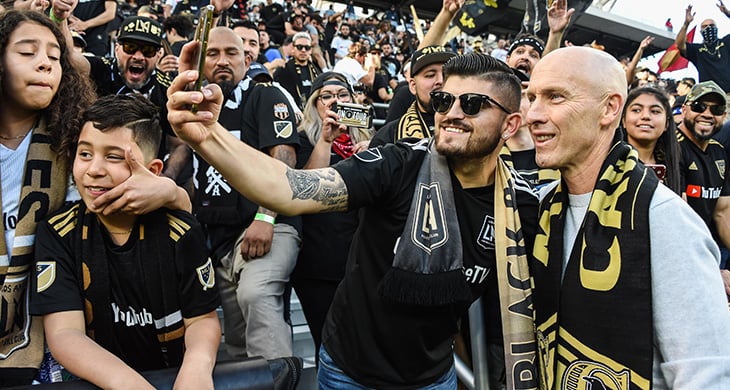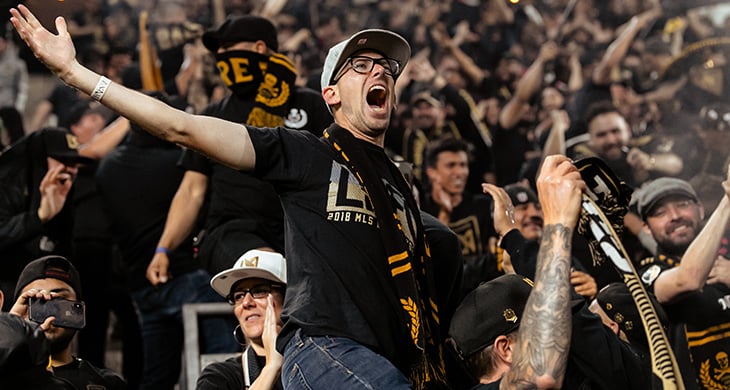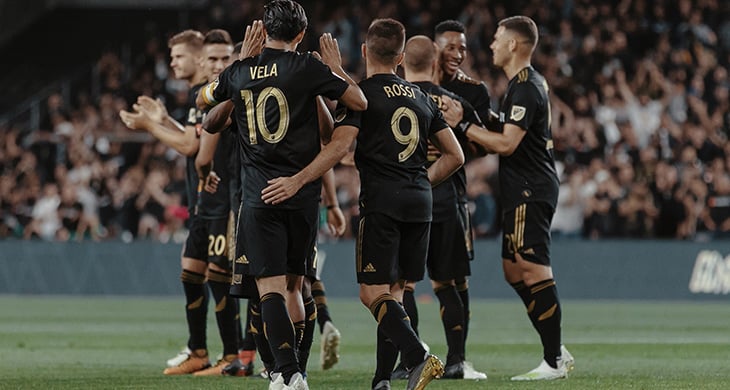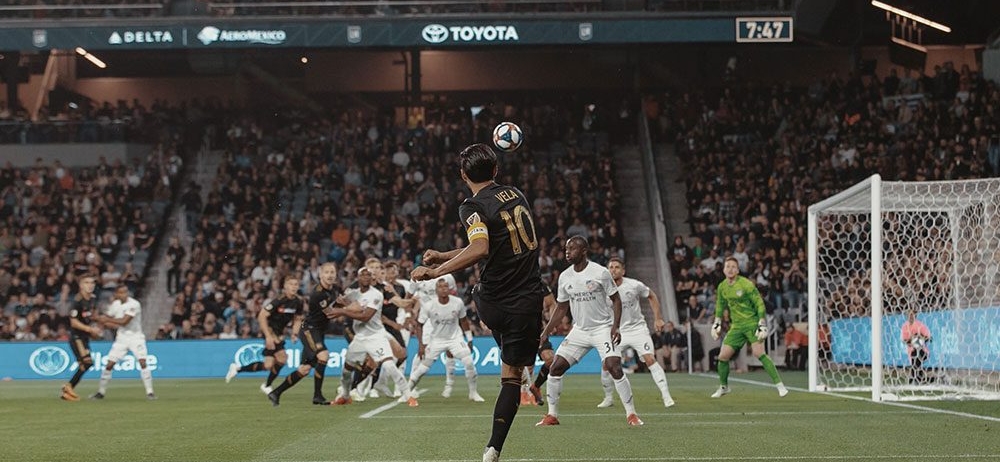How LAFC Became A City-wide Soccer Sensation — In Just One Season
It starts at the Downtown Santa Monica Metro station, just a short walk away from the Fairmont Miramar — a person here, a person there, decked out in Los Angeles Football Club jerseys. The shirts are hard to miss: All black with gold trim and the LAFC crest, they’re infused with Art Deco flourishes inspired by Los Angeles’ design past.
As the Expo Line train makes its way eastward through Culver City, Crenshaw, and eventually to the University of Southern California, the numbers increase. By the time the train arrives near the stadium, the car is filled with a diverse cross-section of Los Angeles: young and old, men and women, different ethnicities and backgrounds.
The team may play in downtown L.A. in the brand-new Banc of California Stadium, but over the course of just one full season so far in Major League Soccer, LAFC has shown itself to be popular everywhere in the sprawling metropolis. And with the best record in MLS (as of May 20th), the team has established that the road to 2019’s MLS Cup championship runs through the City of Angels.
“I think the diversity of the city is incredible,” says head coach Bob Bradley. “And in that diversity, you find real passion for football. [We have an] ability to connect with all parts, all neighborhoods. When I look into the stands, for me it’s special to see boys and girls, mothers and fathers, brothers and sisters, wearing our black and gold. It’s a real indication that we’ve reached everyone, and that’s important to us.”

Bradley is no stranger to launching new teams. Part of his long, distinguished resume (he’s a former national team coach, and the first American to coach in the English Premier League) includes a stint as an assistant coach at D.C. United during the league’s inaugural season. Two years later, he became the head coach of the then-expansion Chicago Fire, leading the team to an MLS Cup Championship in its first campaign. Then, two decades on, he walked Los Angeles Football Club onto the field for its first game, a 1-0 win in Seattle. What was different here?
“Los Angeles is a special city,” he says, “and I think we had people inside the organization really doing an incredible job of going into every neighborhood and creating momentum and energy [around] the team. From the beginning, we felt such a strong connection with the supporters and the city.”
Also on Bradley’s resume: A stint coaching at Chivas USA, the “other” Los Angeles soccer team in the 2000s, which shared a stadium with the Los Angeles Galaxy in the southern suburb of Carson, California. But while Chivas set out with a similar goal to LAFC in terms of being a team of the community, it always struggled to escape the Galaxy’s shadow (especially when the latter added global superstar David Beckham to the roster). The team folded in 2014.
LAFC’s success, on the other hand, largely comes from that momentum that’s been created throughout the city, says Bradley. “And then when you have your own stadium, which is right in the heart of the city, where you have this incredible atmosphere… that was never the case at Chivas USA.”

At “The Banc,” as it’s often called, much of that atmosphere starts with the “3252,” the union of independent groups of supporters that occupy the stadium’s northern end. For 90 minutes, the fans stand, cheer, sing, wave flags and, at certain moments, set off smoke displays. It’s a touch of Europe in America, with hardcore supporters giving their all to back the players. (The players always return the gesture at the end of the game, walking to the north end and applauding the fans.)
The 3252 is comprised of groups from all over the southland: There’s the Lucky Boys, a group made up of patrons of the same bar in Pasadena. There’s the Cuervos, based out of the San Fernando Valley. The Armada represents the South Bay and the area around Los Angeles International Airport. There are groups from Koreatown and the Inland Empire, as well.
That connection to the community means a great deal to LAFC forward Adrien Perez. The Ontario, California native has, throughout his playing career, suited up for Los Angeles-area teams: He played college soccer at Loyola Marymount University, then joined the lower-division Ontario Fury. Now, he’s playing for the current best team in MLS.
“It means everything to me,” he says. “Coming from the area, this is where you want to be. For anyone who has a dream of playing soccer in LA, you’d want to play for Los Angeles Football Club since they’ve been a team here. Everyone’s fallen in love with LAFC, how they incorporate everyone, try to get everyone involved — street by street, block by block.”

That idea of representing a city or a neighborhood is a trademark of soccer cultures around the world. In a place like London, which has six different teams in the Premier League and countless more at lower levels, which team someone roots for can often change block-by-block. In Los Angeles, with the Galaxy’s stadium situated outside of the city, it has become LAFC’s place to try and capture.
FC Cincinnati midfielder Frankie Amaya knows something about representing a neighborhood or city. He grew up in nearby Santa Ana, California, before playing a season of college soccer at UCLA. “Every time I put that jersey on, I’ve got something to fight for,” he says. “It’s me, my teammates, and my city. Like every other crest that I’ve worn, I’ve always fought for that crest, and I’ll continue to fight for it.”
On the night of April 13th, F.C. Cincinnati challenged the high-powered LAFC offense, but the home side still walked out with a 2-0 winner thanks to goals from midfielder Mark-Anthony Kaye and international superstar Carols Vela (his league-leading eighth goal of the season, at the time of the game — Vela still leads MLS in goals with 14 in 14 games played, as of May 20th).
The walk back to the Expo Line and the ride back to Santa Monica (and even the walk from the station to the Fairmont Miramar) found fans in good spirits, stopping off at bars along the way. For another night, the city — the entire city — was well represented.
All photos courtesy of @LAFC

